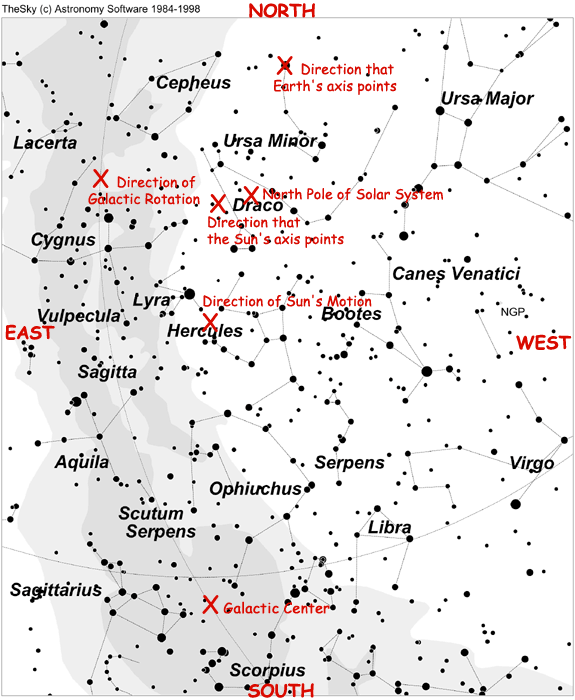
| MadSci Network: Astronomy |
Hello Tom,
When you ask if the Sun moves in a plane perpendicular to its axis, I'm
not
sure if you are refering to its apparent motion in the sky throughout the
year or its motion while orbiting the center of the galaxy. Either way,
the answer is no.
The Sun's apparent motion through the sky throughout the year is a line called the ecliptic. This motion is actually the result of Earth orbiting about the Sun. Earth orbits the Sun in a plane. Since we are in that plane it looks like a line in the sky: the ecliptic. Nearly all of the other planets orbit in planes very close to the ecliptic plane. So Earth's plane is defined as the plane of the Solar System. Earth's axis of rotation is tilted by 23.5 degrees from perpendicular to the ecliptic plane. Perpendicular from the ecliptic plane is a location in the center of the constellation Draco. Instead, Earth's axis points at a star in the constellation Ursa Minor (or the little dipper) called Polaris, also known as The North Star. The Sun's axis of rotation is very close to perpendicular to the ecliptic plane. It is tilted by only 7.5 degrees from perpendicular to the ecliptic plane, also pointing into the constellation of Draco. You can see all of this in the image of the sky below.
The Sun also orbits about the center of the Milky Way Galaxy at a distance of about 25,000 light-years located in the constellation of Sagittarius. From the perspective of our Solar System, the Galaxy rotates in a direction toward the constellation of Cygnus. It takes over 200 million years for the Solar System to complete one orbit about the center of the Galaxy. The plane of the Solar System (i.e. the ecliptic plane) is quite tilted relative to the plane of the Milky Way Galaxy, which is a flat disk of stars with a central bulge. The plane of the Solar System is tilted by about 63 degrees relative to the plane of the Galaxy, and it is tilted toward the direction that the Sun is traveling in space.
The Sun and all of its neighboring stars are generally heading in the direction of the constellation Cygnus. However, the Sun's motion through the Galaxy is constantly perturbed by the gravity of other stars and star clusters nearby in the Galaxy. It has a component of motion up and down through the plane of the Galaxy, rather like that of a pony on a merry-go- round. It also has a component of motion in toward the center of the Galaxy and back out again. So its motion through the Galaxy is rather complex and not in a plane at all. The current direction of the Sun's motion is toward the constellation of Hercules.
I know that to visualize this really requires a 3-D model in your hands, but I hope the picture of the sky below will help you out a little.
Best of luck,
Bryan Méndez, UC Berkeley Space Sciences Laboratory

Try the links in the MadSci Library for more information on Astronomy.